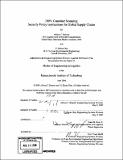| dc.contributor.advisor | James B. Rice, Jr. | en_US |
| dc.contributor.author | Bennett, Allison C. (Allison Christine) | en_US |
| dc.contributor.author | Chin, Yi Zhuan | en_US |
| dc.contributor.other | Massachusetts Institute of Technology. Engineering Systems Division. | en_US |
| dc.date.accessioned | 2009-04-29T17:14:44Z | |
| dc.date.available | 2009-04-29T17:14:44Z | |
| dc.date.copyright | 2008 | en_US |
| dc.date.issued | 2008 | en_US |
| dc.identifier.uri | http://hdl.handle.net/1721.1/45248 | |
| dc.description | Thesis (M. Eng. in Logistics)--Massachusetts Institute of Technology, Engineering Systems Division, 2008. | en_US |
| dc.description | Includes bibliographical references (leaves 164-169). | en_US |
| dc.description.abstract | On August 3, 2007, President George Bush signed into law HR1 the "Implementing Recommendations of the 9/11 Commission Act of 2007." The 9/11 Act requires 100% scanning of US-bound containers at foreign seaports by 2012 through the use of non-intrusive (NII) and radiation detection equipment. Maritime stakeholders and the government community have actively debated the feasibility of this plan, citing economic impacts, barriers to global trade and insufficient technology and physical space. This thesis focuses on importer concerns relating to potential shipment delays, financial burdens, sourcing issues and contingency planning concerns in global supply chain operations. Using port statistics, field study data as well as industry insights, frameworks are developed to identify major stakeholder issues and quantify the financial costs and delay risks bourn across the entire supply chain. Cost and delay analyses are based on 2 prototypical ports - a small/low-volume export port and a large/high-volume export port. Cost analysis is performed for a consolidated (port authority) level installation and a segmented (terminal operator) level installation to calculate a per-box scanning fee. Queuing models and Monte-Carlo simulations are also developed to quantify truck congestion due to primary scanning and the risk of containers missing vessels due to secondary inspections. Results of the cost analysis indicate that scanning configurations, particularly related to NII, greatly affect the-per box scanning cost. It is not economically feasible to scan only US-bound containers at half of the 600 ports with direct connections to the US. Analysis of truck congestion suggests that the ramp metering effect of the entry gate can help to abate congestion at the scanning area. | en_US |
| dc.description.abstract | (cont.) Analysis on secondary inspection delays revealed that under a set of assumptions that reflect current operations, the risk of containers missing sailings could potentially increase to 1.5%, which may in turn require a 0.5% to 5% increase in safety stock. Our study shows that cost and delay implications of 100% export US-bound container scanning may be less severe than industry anticipated. Supply chain disruptions due to scanning is best mitigated through earlier container dispatch, increased safety stock or increased scanning infrastructure and personnel at ports. | en_US |
| dc.description.statementofresponsibility | by Allison C. Bennett and Yi Zhuan Chin. | en_US |
| dc.format.extent | 174 leaves | en_US |
| dc.language.iso | eng | en_US |
| dc.publisher | Massachusetts Institute of Technology | en_US |
| dc.rights | M.I.T. theses are protected by
copyright. They may be viewed from this source for any purpose, but
reproduction or distribution in any format is prohibited without written
permission. See provided URL for inquiries about permission. | en_US |
| dc.rights.uri | http://dspace.mit.edu/handle/1721.1/7582 | en_US |
| dc.subject | Engineering Systems Division. | en_US |
| dc.title | 100% container scanning : security policy implications for global supply chains | en_US |
| dc.title.alternative | One hundred percent container scanning : security policy implications for global supply chains | en_US |
| dc.type | Thesis | en_US |
| dc.description.degree | M.Eng.in Logistics | en_US |
| dc.contributor.department | Massachusetts Institute of Technology. Engineering Systems Division | |
| dc.identifier.oclc | 310353844 | en_US |
